Listen to an audio story by Annenberg Radio News
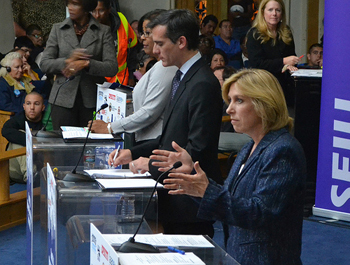 In Tuesday’s mayoral election, about one-third of voters cast their ballots for Councilman Eric Garcetti and one-third for Wendy Greuel, propelling both candidates on to the May 21 runoff election. In the coming months, it’s all eyes on that remaining third–a group that includes many South L.A.voters.
In Tuesday’s mayoral election, about one-third of voters cast their ballots for Councilman Eric Garcetti and one-third for Wendy Greuel, propelling both candidates on to the May 21 runoff election. In the coming months, it’s all eyes on that remaining third–a group that includes many South L.A.voters.
Most of Garcetti’s votes came from the Westside through Hollywood and out into the East side. Greuel cleaned up in the Valley, where she used to be a councilwoman. Conservative Kevin James picked up more than 16 percent of the vote–with pockets of support scattered around the city. Councilwoman Jan Perry got just shy of 16 percent of the vote–with the vast majority of her votes coming from South L.A. Perry took 60 or 70 percent of the vote in some South LA neighborhoods.
“She dominated in South L.A.,” said Kokayi Kwa Jitahidi of The South Los Angeles Power Coalition. “Which puts her and her voters in a very, very strong position to determine who the next mayor will be.”
South L.A.’s voters–many of whom are African-American, could go either way in May.
“I think they’re up for grabs,” said former Los Angeles Daily News Editor Ron Kaye. “The question is will anybody vote? And is anything at stake that makes people want to vote?”
Perry’s primary campaign was more critical of Greuel than it was of Garcetti, which may improve Garcetti’s chances with her supporters. And many Latino groups have thrown support behind Garcetti, which could be significant in South LA, where more than 60 percent of residents are Latino. The Latino Coalition of Los Angeles PAC–an organization focused on representing the political interests of South American and Central Americans–officially endorsed Garcetti before the primary.
“Garcetti is a coalition builder,” said Latino Coalition president and founder Raul Claros. “He’s embraces the Latino coaltion’s focus.”
The group is also backing Ana Cubas in the Council District 9 election.
“When we met with them, Cubas and Garcetti had a comprehensive, logistical, practical and concrete plan for South LA,” said Claros.
Jitahidi said both Greuel and Garcetti have made promises to South L.A., and wants someone who will keep their promises to be elected. He said Mayor Antonio Villaraigosa courted South L.A. in his mayoral campaign, but failed to deliver on his pledges.
“Both of them have given rhetoric to working with South L.A.,” Jitahidi said. “I think whoever wins has to be committed to actually making those promises true. I think only way we do that is if South L.A. really organizes in a coordinated and consistent way.”
He says he’ll be focused on boosting voter turnout. Turnout around the city was just 16 percent Tuesday, and even lower in South L.A.









 There are some big changes coming to South LA’s Manual Arts High School, and not everyone is excited about them.
There are some big changes coming to South LA’s Manual Arts High School, and not everyone is excited about them. 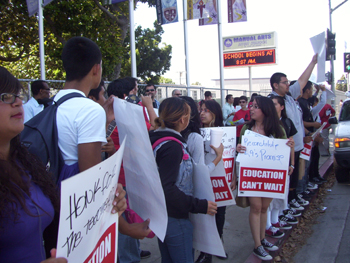 Some, like Manual Arts teacher Daniel Beebe, see this effort to turn the troubled school around as misguided.
Some, like Manual Arts teacher Daniel Beebe, see this effort to turn the troubled school around as misguided.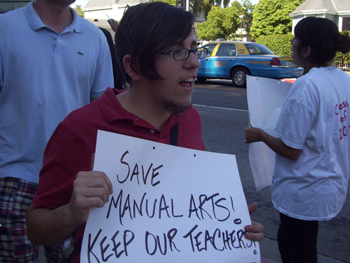 Between 30 and 40 percent of Manual Arts’ teachers were shifted just last year, according to UTLA. And one-third of the schools’ staff has been reassigned to the new Augustus Hawkins High School when it opens in the fall.
Between 30 and 40 percent of Manual Arts’ teachers were shifted just last year, according to UTLA. And one-third of the schools’ staff has been reassigned to the new Augustus Hawkins High School when it opens in the fall. 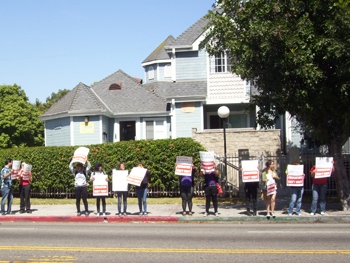 Travis Miller, a ninth grade English teacher at Manual Arts attributes the school’s problems to “constant administrative mismanagement.” In his 12 years at the school, he says he’s answered to 10 different principals.
Travis Miller, a ninth grade English teacher at Manual Arts attributes the school’s problems to “constant administrative mismanagement.” In his 12 years at the school, he says he’s answered to 10 different principals.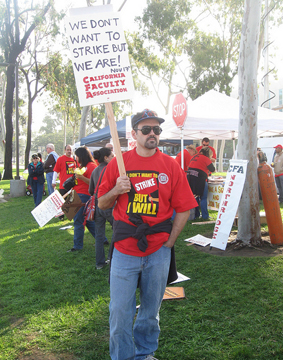 Hundreds gathered to picket in front of CSU Dominguez Hills Thursday. The Carson campus is one of two CSU campuses staging walkouts. The other is CSU East Bay, but professors from Cal State’s 23 campuses around California joined the protest. The strike comes just one day after CSU student protests over a nine percent tuition hike turned violent.
Hundreds gathered to picket in front of CSU Dominguez Hills Thursday. The Carson campus is one of two CSU campuses staging walkouts. The other is CSU East Bay, but professors from Cal State’s 23 campuses around California joined the protest. The strike comes just one day after CSU student protests over a nine percent tuition hike turned violent. 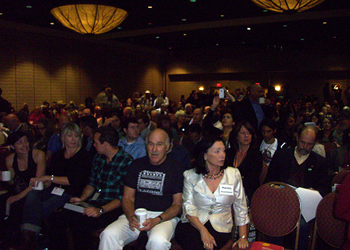
 Immigrant leaders from Honduras, Nicaragua and El Salvador gathered outside the federal building in downtown Los Angeles today to call for an extension of the Temporary Protected Status (TPS) agreement that guards undocumented nationals from those countries against deportation.
Immigrant leaders from Honduras, Nicaragua and El Salvador gathered outside the federal building in downtown Los Angeles today to call for an extension of the Temporary Protected Status (TPS) agreement that guards undocumented nationals from those countries against deportation. 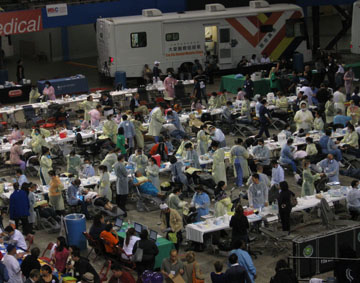 Today was the first day of a four-day health clinic in The Los Angeles Sports Arena that’s expected to bring in five-thousand uninsured and underinsured patients seeking basic health care.
Today was the first day of a four-day health clinic in The Los Angeles Sports Arena that’s expected to bring in five-thousand uninsured and underinsured patients seeking basic health care. 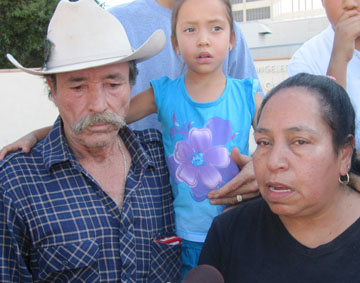 The family of Jorge Rosales gathered outside the Twin Towers Jail in Los Angeles today to mourn and call for justice.
The family of Jorge Rosales gathered outside the Twin Towers Jail in Los Angeles today to mourn and call for justice.  United Teachers Los Angeles (UTLA) is calling on the district to rehire 1,200 teachers and support staff that were laid off last spring due to budget cuts.
United Teachers Los Angeles (UTLA) is calling on the district to rehire 1,200 teachers and support staff that were laid off last spring due to budget cuts.  A small crowd holding “Obama 2012” campaign signs stood on the sidewalk outside talk show host Tavis Smiley’s headquarters today. They were there to denounce Smiley and Author Cornel West’s call to challenge the president in 2012.
A small crowd holding “Obama 2012” campaign signs stood on the sidewalk outside talk show host Tavis Smiley’s headquarters today. They were there to denounce Smiley and Author Cornel West’s call to challenge the president in 2012. 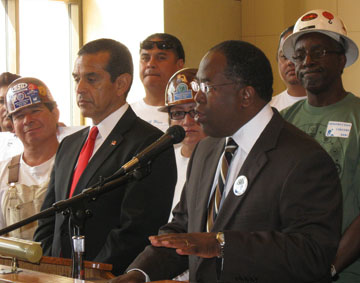 Los Angeles has a reputation as the ultimate car city, but thousands of its residents still rely on public transit.
Los Angeles has a reputation as the ultimate car city, but thousands of its residents still rely on public transit.




